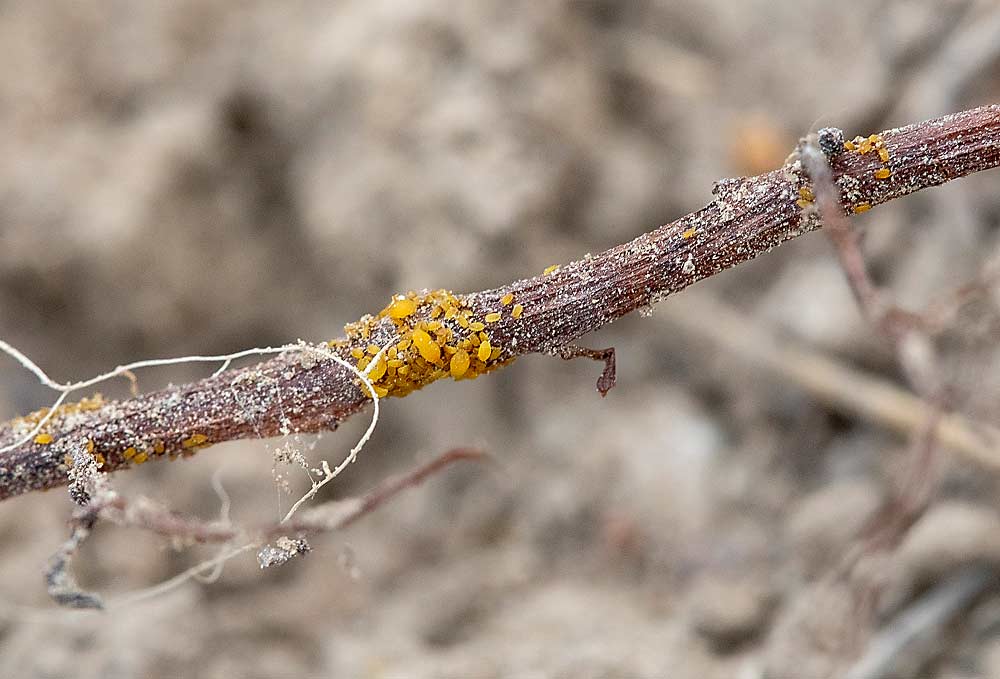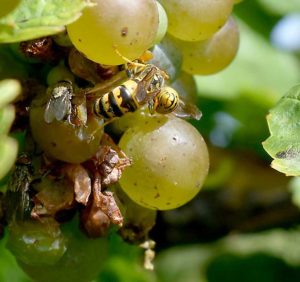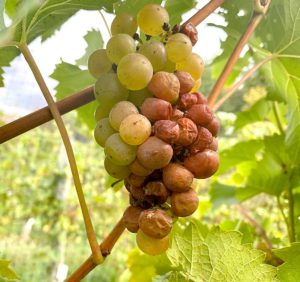
From the beginning of the growing season to the end, there’s no shortage of insects that want to eat your grapes.
Michigan State University entomology professor Rufus Isaacs listed some vineyard insect pests, and ways to manage them, during a grape session at the Great Lakes Fruit, Vegetable, and Farm Market EXPO in December.
He started during dormancy with a pest most Michigan grape growers might not be familiar with: the erineum mite.
Northwest Michigan vineyards have had some challenges with the grape erineum mite in the past few years. The microscopic mite makes a “weird patch of fuzzy white” on leaves. When the mite becomes active and starts walking on leaves, the leaves respond by making “a very high density of hairs on the underside of the leaves, like a little forest that (the mites) can live and hide in, then sneak out to eat your grape leaves,” Isaacs said.
A trial held in a Northwest Michigan vineyard revealed that the best way to control the erineum mite is by applying Envidor (spirodiclofen) at bud swell.
During bud swell, the primary pests to monitor are cutworms and flea beetles. Cutworms can move around at night. They chew on and remove buds. Flea beetles fly on sunny days, boring into and damaging buds. Isaacs’ “rough rule of thumb” is that if 2 percent of buds are damaged by these pests, it’s time to apply protections. Trunk sprays can control cutworms, but they don’t control flea beetles. Sevin (carbaryl) or pyrethroid insecticides are effective. Some newer insecticide classes can work at this timing, too, he said.
As shoots start to grow, rose chafers and potato leafhoppers might show up. Shoots and leaves are growing quickly at this point, and these pests like to feed on the untreated foliage. Rose chafers tend to fly in from grassy areas next to vineyards. Most vines can withstand a little bit of leaf feeding, but rose chafers also feed on grape clusters.
The good news is they are very attracted to commercially available traps, he said. These are similar to Japanese beetle traps but have a rose chafer-specific lure.
The potato leafhopper relies heavily on the weather. A migratory insect, it arrives in Michigan in May on winds from the south. Michigan’s 2023 season was very dry, however, and neither the southern winds nor the pest ever arrived. In years when it does arrive, potato leafhopper can have very negative effects on young plantings of susceptible cultivars, causing curling leaves and stunting shoots.
There are a number of effective tools for controlling rose chafers and leafhoppers, Isaacs said, especially neonicotinoid insecticides.
At bloom, Isaacs said it is time to start worrying about the historic “scourge of the grape industry” — phylloxera. Many grape rootstocks are resistant to the root-feeding insect, but in humid regions the foliar form of the pest can cause intensive leaf infestations in hybrid cultivars, stunting vineyard growth. If needed, growers can nip the pest in the bud with early insecticide applications. Movento (spirotetramat) provides excellent phylloxera control.

Early applications of Movento also work well against the grape tumid gallmaker, a sporadic pest in Michigan that can cover clusters with a “horrible-looking swelling,” he said. It’s one of many species of gall midges — small flies that feed on plant tissue as larvae, creating galls.
Grape berry moth starts to show up around bloom and sticks around until harvest. The pest requires regular scouting, especially in vineyard hot spots. Clusters need the most protection during key infestation periods: bloom, fruit set, berry touch and post-veraison. The sooner you spot the pest, the better you can control it, Isaacs said.
Newer insecticides with long residual activity — Intrepid (methoxyfenozide), Intrepid Edge (methoxyfenozide and spinetoram), Altacor (chlorantraniliprole) and Verdepryn (cyclaniliprole) — provide good grape berry moth control.
“If you get all the way to harvest and realize you have a very tough problem, it’s really hard to clean that up,” Isaacs said. “The more you can do during the season to prepare, the better.”
Finally, he discussed the relationship between the invasive spotted wing drosophila (SWD), the standard vinegar fly and sour rot. SWD’s ability to cut into ripening grapes enables vinegar fly feeding, which appears to drive sour rot infestation. Thinning grape clusters using horticultural methods can lessen sour rot risk. Recent MSU research indicates that applications of Leverage 360 (imidacloprid and cyfluthrin), Mustang Maxx (zeta-cypermethrin) or Entrust (organic spinosad) starting at 15 Brix can reduce both vinegar flies and sour rot.
—by Matt Milkovich








Leave A Comment